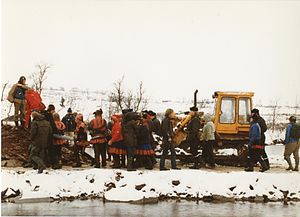
Environmental injustice is the exposure of poor and marginalised communities to a disproportionate share of environmental harms such as hazardous waste, when they do not receive benefits from the land uses that create these hazards.[1] Environmental racism is environmental injustice in a racialised context. These issues may lead to infringement of environmentally related human rights.[2]: 10 [3]: 252 Environmental justice is a social movement to address these issues.
In Europe, environmental racism has been postulated in particular toward Romani communities. According to Trehan and Kocze (2009), "EU accession for the post-socialist countries has resulted in a de facto centre and periphery within Europe itself, thus exacerbating the already marginal economic and political position of Roma in Europe whose communities continue to subsist as internal colonies within Europe."[3]: 264 This peripheral position, in which segregated Romani settlements and their inhabitants become viewed as de-territorialized zones "beyond the pale" of government responsibility and European Union citizenship,[3]: 264 has been identified by some scholars as an aggravating factor in the prevalence of environmental hazards (such as proximity to industrial facilities and illegal or toxic waste dumps).[2]: 19–20 [3]: 252, 263 [4]: 74–5 This practice has been identified in relation to the lack of basic services such as water, housing, sanitation[2]: 19–20 [3]: 263 and access to education[5]: 238–9 affecting marginalized Romani communities.
- ^ Schlosberg, David. (2007) Defining Environmental Justice: Theories, Movements, and Nature. Oxford University Press.
- ^ a b c Steger, Tamara et al. eds. Making the Case for Environmental Justice in Central & Eastern Europe. Archived October 6, 2016, at the Wayback Machine Budapest: CEU Center for Environmental Policy and Law, The Central European University; The Health and Environment Alliance; and The Coalition for Environmental Justice, March 2007. pp. 1–57. Web. April 10, 2016.
- ^ a b c d e Harper, Krista; Steger, Tamara; Filčák, Richard (2009). "Environmental Justice and Roma Communities in Central and Eastern Europe". Environmental Policy and Governance. 19 (4): 251–268. CiteSeerX 10.1.1.893.1144. doi:10.1002/eet.511.
- ^ Orta, Lucy; et al., eds. (2010). Mapping the Invisible: EU-Roma Gypsies. London, UK: Black Dog Publishing.
- ^ Pellow, David Naguib (2007). Resisting Global Toxics: Transnational Movements for Environmental Justice. Cambridge, Massachusetts: MIT Press. ISBN 9780262264235.
